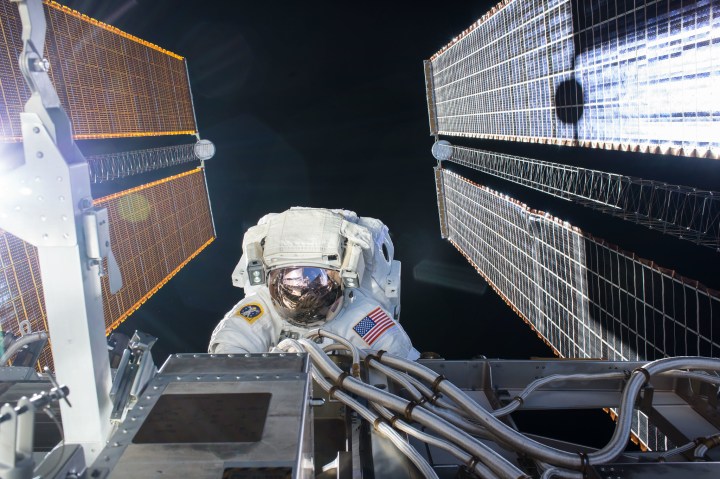
NASA astronauts Kate Rubins and Victor Glover are currently performing a spacewalk outside of the International Space Station, working to upgrade the station’s solar arrays. The two astronauts began their spacewalk at 6:12 a.m. ET (3:12 a.m. PT) on Sunday, February 28, and they are expected to spend the rest of the morning carrying out upgrade work.
The station will soon have new solar arrays installed — the four large pairs of solar panels which collect energy from the sun to power the station’s needs. The current solar arrays have been in constant use since the first pair were deployed in December 2000. Though the arrays are still functioning, they were only designed for a 15-year life originally, so their performance has degraded over time and it’s time they got replaced. The new arrays will be more efficient and should give a 20% to 30% boost to the station’s power, even though they are smaller than the current arrays.
Before the new arrays can be installed, however, the ISS crew has to prepare the outside of the station with modification kits. That’s the task of Rubins and Glover today, who will be moving along the station’s backbone truss structure to the far left side set of solar arrays for the first upgrade. “The spacewalkers will work together to construct and begin installing bracket support structures at the base of the current solar arrays that will enable new solar arrays to be installed to augment the space station’s power supply,” NASA said in a blog post.
The new arrays will be installed later this year.
This will be the first of a pair of spacewalks, with the second to follow on Friday, March 5. This subsequent spacewalk will be performed by Rubins once again, along with JAXA astronaut Soichi Noguchi.
If you’d like to watch today’s spacewalk live, NASA is livestreaming the event and we have all the details on how to watch. The spacewalk is scheduled to last for six and a half hours, until around 12:30 p.m. ET (9:30 a.m. PT). Rubins is extravehicular crew member 1 (EV 1) and is in a suit with red stripes, while Glover is EV2 and is in a suit with no stripes.
Editors' Recommendations
- Junk from the ISS fell on a house in the U.S., NASA confirms
- These 3 companies are developing NASA’s new moon vehicle
- Around-the-clock 4K Earth imagery to be streamed from ISS
- NASA and Boeing start fueling Starliner spacecraft for first crewed flight
- NASA’s Crew-7 astronauts splash down safely off the coast of Florida




